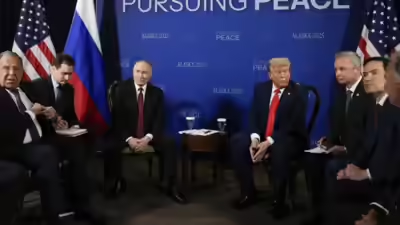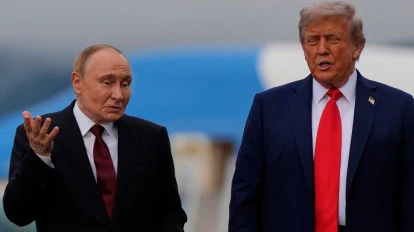No Deal or Ceasefire: What the ‘Failed’ Trump-Putin Alaska Summit Could Mean for India
The much-hyped Alaska summit between U.S. President Donald Trump and Russian President Vladimir Putin ended with no deal, no ceasefire, and plenty of unanswered questions. For weeks, the international community had been watching closely, with speculation that Trump would use the meeting to press Moscow for a truce in Ukraine. But as the dust settled, it became clear that little had been achieved.

Putin, who had been branded a global pariah since the invasion of Ukraine, walked away with exactly what he wanted—a return to the world stage. Trump, on the other hand, left looking tired, weary, and short on answers. For India, which has long balanced its ties between Washington and Moscow, the “failed” summit raises complex questions about strategy, trade, and diplomacy.
The Build-Up to the Alaska Summit
Trump had made no secret of his desire to reset ties with Moscow. In the run-up to the meeting, his administration rolled out the proverbial red carpet for Putin, signaling openness to dialogue despite months of rising tensions. Trump hinted at a tougher stance on Russia in the weeks before the summit, warning of possible sanctions if Moscow did not agree to a ceasefire in Ukraine.
Yet, when the two leaders met in Alaska, the dynamics seemed to tilt in Putin’s favor. In the post-summit briefing, it was the Russian leader who spoke first, setting the tone. Trump followed later, appearing fatigued and offering no concrete breakthroughs. Both men avoided taking questions from reporters, further fueling doubts about what, if anything, had actually been discussed behind closed doors.
What Putin Gained
For Putin, the optics of the summit were a victory in themselves. In one stroke, he transitioned from international isolation to sharing the stage with the U.S. President. This was no small feat. The very act of meeting Trump on equal footing gave him legitimacy and a chance to project strength back home in Moscow.
Crucially, he made no concessions. There was no commitment to ceasefire, no roadmap for peace in Ukraine, and no signal that Russia was ready to shift course. Instead, Putin secured his global spotlight, while Trump left with little to show for the effort.
What Trump Lost
For Trump, the Alaska summit carried risks from the start. He had staked his credibility on the idea that he could negotiate with Moscow and bring an end to the conflict in Ukraine. By failing to secure even the outline of a deal, Trump opened himself up to criticism from allies and rivals alike.
The fact that Putin dictated the sequence of the press briefing—speaking first, while Trump looked visibly drained—only added to the perception of imbalance. For the U.S., the result was a diplomatic setback. For Trump personally, it was a reminder of how difficult it is to deal with Putin, who rarely leaves a negotiation empty-handed.
Why the Summit Matters for India
While the immediate focus of the Alaska summit was the U.S.-Russia dynamic, India has much at stake in how these relationships evolve. New Delhi has historically balanced strong ties with Moscow with its growing strategic partnership with Washington. A failed summit between Trump and Putin complicates that balancing act in several ways.
- Energy and Defense Partnerships with Russia
India relies heavily on Russia for defense supplies, including fighter jets, missile systems, and spare parts. Moscow has also been a key partner in energy projects. If the U.S. ramps up sanctions on Russia following the failed summit, India could face new challenges in maintaining these ties without angering Washington. - Strategic Convergence with the U.S.
At the same time, India’s relationship with the U.S. has deepened significantly, especially in the Indo-Pacific. Washington views New Delhi as a key partner in countering China’s growing influence. But Trump’s inability to rein in Putin may force the U.S. to adopt a tougher stance against Moscow, putting India in a position where it must walk a fine diplomatic line. - Ukraine Conflict and Global Food/Energy Prices
The ongoing war in Ukraine has already disrupted global food and energy markets, driving up costs for countries like India. If no ceasefire is in sight after the Alaska summit, these pressures are likely to intensify. For a country that imports large amounts of energy, instability in global markets could hit India hard.
The Ceasefire That Never Was
One of the main expectations going into the summit was that Trump would secure some form of ceasefire commitment from Putin. That did not happen. Instead, Putin stuck to his well-rehearsed narrative, insisting that NATO expansion and Western interference had left him with no choice but to act.
Trump, despite earlier threats of harsher measures, did not push back with new sanctions or ultimatums. The absence of any timeline for future talks further reinforced the sense of stalemate. The ceasefire that many had hoped for remains elusive, prolonging uncertainty on the battlefield and in diplomatic corridors alike.
Global Reactions
Reactions to the summit have been mixed. European leaders expressed disappointment, with some warning that the outcome signaled weakness in U.S. diplomacy. Ukraine’s leadership, meanwhile, was visibly frustrated, stressing that the lack of progress gave Russia more time to consolidate gains on the ground.
In contrast, Moscow celebrated the event as proof that Putin could not be ignored. Russian state media portrayed the Alaska summit as a triumph, focusing on images of Putin and Trump side by side.
What Next for Trump?
The failed summit leaves Trump with difficult choices. Will he return to his earlier threats of new sanctions on Russia? Or will he attempt another meeting with Putin, hoping for a different outcome? So far, no dates have been set for a follow-up, and the lack of clarity only deepens the sense of drift in U.S. policy toward Russia.
For Trump domestically, the optics of being outmaneuvered by Putin could carry political costs. For his foreign policy agenda, it is a reminder that bold promises are harder to deliver when dealing with seasoned adversaries.
What Next for India?
For India, the priority now is to watch how U.S.-Russia relations unfold in the aftermath of the summit. If Washington escalates pressure on Moscow, New Delhi may need to find creative ways to sustain its defense and energy partnerships with Russia while avoiding friction with the U.S.
India’s long tradition of strategic autonomy will likely come into play. Maintaining balance between two powerful partners, both of whom are moving further apart, will be no easy task. But as the Alaska summit has shown, global power politics often leave middle players like India navigating the gray areas.
A Summit That Changed Nothing—Or Did It?
At first glance, the Trump-Putin Alaska summit seems like a failure: no deal, no ceasefire, no roadmap for peace. Yet, it may prove significant in another way. By allowing Putin to regain international visibility without making concessions, the meeting highlighted just how entrenched the conflict has become.
For the U.S., it was a reminder that confronting Russia will require more than one summit and more than personal diplomacy. For Russia, it was proof that time and optics can sometimes matter as much as substance.
And for India, the message is clear: the war in Ukraine is far from over, and its ripple effects will continue to shape global politics, trade, and strategy. In a world where major powers play hardball, India must remain agile, pragmatic, and ready for a future where no summit guarantees certainty.
Follow us for more news at Valleynewz.com

